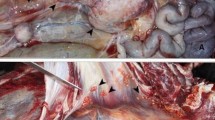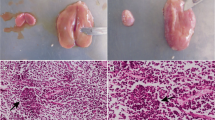Summary
Single infections or even epizootic forms of tuberculosis are common in birds of zoological gardens and game birds in farms as well. They cause economic damage, and the most important of them,Mycobacterium avium, can cause nearly fatal disease in humans. In this article, an epidemic of tuberculosis in pheasants raised on a farm has been described. The disease appeared in a breeding flock of 800 females and 140 males. Clinically affected birds expressed depression, anorexia and loss of weight. The mortality rate was 1–5 birds per day. Blood samples taken from 20 randomly chosen pheasants were agglutinated by use of avian tuberculin, and all were positive. Pathomorphological examination of carcasses of already dead or killed moribund pheasants revealed creamy nodules, mostly in the intestine, liver and spleen, varying in size from miliary to several centimetres in diameter. Pathohistological finding can be described asTuberculosis nodularis partim nodosa et coligranuloma. The colonies that grew on selective nutrient media were identified asMycobacterium sp., most probablyM. avium-intracellulare complex. Based on the findings described, all birds of the farm were killed, the most severely affected carcasses burned and all of them buried near the farm.
A recommendation was given to start constant monitoring of game birds as well as zoo birds, primarily to prevent infection in humans and free living birds.
Zusammenfassung
Einzelfälle von Tuberkulose oder sogar ihre epizootische Form sind bei Vögeln in den zoologischen Gärten und beim Federwild auf den Farmen sehr häufig. Es entstehen wirtschaftliche Schäden und das wichtigste jedoch ist, daß dasMycobacterium avium bei Menschen eine fatale Krankheit verursachen kann. In dieser Arbeit ist die enzootische Form der Tuberkulose bei Fasanen in Farmzucht beschrieben.
Die Krankheit ist in einer Zuchtpopulation von 800 weiblichen und 140 männlichen Tieren ausgebrochen. Klinisch kranke Vögel zeigten Depression, Anorektie und Magersucht. Es starben ein bis fünf Vögel täglich. Die Blutproben von 20 auf Verdacht ausgesuchten Fasanen wurden mit aviärem Tuberkulin agglutiniert und alle waren positiv. Die patho-morphologische Untersuchung von Kadavern oder von erkrankten getöteten Fasanen zeigte gelbe Knötchen, hauptsächlich an Darm, Leber und Milz mit unterschiedlicher Größe von miliaren bis einige Zentimeter Durchmesser. Den pathologischen Befund kann man alsTuberculosis nodularis partim nodosa et coligranuloma beschreiben.
Die bakteriellen Kolonien auf den Nährböden wurden alsMycobacterium avium sp., am wahrscheinlichsten als komplexM. avium-intracellulare identifiziert. Aufgrund des beschriebenen Befundes wurde die gesamte Vogel-Population geopfert und verbrannt oder in der Farmnähe vergraben.
Es wurde eine Empfehlung ausgesprochen, die zur Einleitung einer umfassenden Überwachung des gesamten Federwildes wie auch der Vögel in zoologischen Gärten führen soll. Dies soll eine Seuchenübertragung auf den Menschen und auf die Vögel in deren Naturlebensräumen verhindern.
Résumé
Des cas isolés de Tuberculose, ou encore sous leur forme épizootique, sont très fréquents dans les jardins zoologiques ainsi que chez le gibier-plume de fermes d'élevage. Il en résulte, certes, des pertes économiques mais ce qui est plus grave, c'est queMyobacterium avium peut causer une maladie mortelle chez l'homme. Dans la présente étude, on décrit l'expression enzootique de la Tuberculose chez des faisans vivant dans une ferme d'élevage.
La maladie a fait son apparition dans un élevage constitué de 800 poules et de 140 coqs. Cliniquement, les oiseaux malades montraient des symptômes de dépression et d'anorexie. De un à cinq oiseaux mouraient chaque jour. Les échantillons de sang prélevés sur 20 sujets suspects furent soumis à un test d'agglutination et se révélèrent tous positifs. L'étude patho-morphologique de cadavres ou de sujets malades achevés montrait, principalement dans l'intestin, dans le foie et dans la rate, des nodules jaunes de taille variant de quelques millimètres à quelques centimètres de diamètre. Le diagnostic pathologique peut s'énoncer comme correspondant à uneTuberculosis nodularis partim nodosa et coligranuloma.
Les colonies bactérielles provenant de sols voisins ont été identifiées comme étantMyobacterium avium sp., et très vraisemblablement comme un complexe deM. avium-intracellulare. Suite à ces constats, la totalité des oiseaux a été sacrifiée, brûlée ou enterrée dans une ferme vosine.
On formule une recommandation qui devrait se traduire par un contrôle généralisé de tout le gibier-plume de même que des oiseaux vivant dans des jardins zoologiques. Ceci devrait empêcher la transmission de l'épidémie à l'homme et aux oiseaux dans leur habitat naturel.
Similar content being viewed by others
References
Behlert, O.;Gerlach H., 1991: Prophylactic measures because of incidences of avian tuberculosis in the pheasantry of Cologne Zoo (Sanierungsmassnahmen in der Fasanerie des Kölner Zoo wegen aviärer Mykobakteriose). Berl. Münch. Tierärztl. Wschr.104, 12–15.
Cvetnić, Ž;Kovačić, H.;Karačeić, V.;Robić, F., 1994: Spreading and meaning of tuberculosis in hens in rural husbandries (Rasprostranjenost i značenje tuberkuloze kokoši u seoskim gospodarstvima). Vet. stanica25, 211–216.
Gerlach, H., 1994:Mycobacterium. In: Avian medicine: principles and application, pp. 971–975 (B. W. Ritchie, G. J. Harrison, L. R. Harrison, Eds.). Lake Worth, Florida: Wingers Publishing.
Greene, J. B.;Sidhu, G. S.;Leasin, S.;Levine, S. F.;Masur, H.;Simberkoff, M. S.;Nicholas, D.;Good, R. C.;Zolla-Pazner, S. B.;Pollock, A. A.;Tapper, M.;Holzman, R. S., 1982:Mycobacterium avium-intracellulare: a cause of disseminated life threatening infection in homosexuals and drugs abusers. Ann. Intern. Med.97, 539–546.
Greinert, U., 1992: Klinik atypischer Mykobacteriosen. Immun. Infekt.20, 32–35.
Gylstorff, I.;Grimm, F., 1987: Vogelkrankheiten. Stuttgart: Eugen Ulmer.
Hawkey, C.;Kock, R. A.;Henderson, G. M.;Cindery, R. N., 1990: Haematological changes in domestic fowl(Gallus gallus) and cranes(Gruiformes) withMycobacterium avium infection. Avian Pathol.19, 223–234.
Hejliček, K.;Treml, F., 1993: The occurrence of avian mycobacteriosis in free-living birds at different epizootological situation of poultry tuberculosis. Vet. Med. Czech.38, 305–317.
Hejliček, K.;Treml, F., 1993: Epizootology and pathogenesis of house-sparrow(Passer domesticus) and mountain-sparow(P. montanus). Vet. Med. Czech.38, 667–685.
Karlson, A. G.;Thoen, C. O., 1980: Tuberculosis. In: Isolation and identification of avian pathogens, pp. 36–39, 2nd ed. (S. B. Hitchner, C. H. Domermuth, H. J. Purchase, J. E. Williams, Eds.). College Station, Texas: Am. Assoc. Avian Pathol.
Kovačić, H.;Lacković, M., 1985: Tuberculosis in the rook (Corvus frugilegus) (Tuberkuloza u vrane gačac —Corvus frugilegus). Vet. arhiv55 (Suppl.) 58–60.
Roffe, T. J., 1989: Isolation ofMycobacterium avium from waterfowl with polycystic livers. Avian Dis.33, 195–198.
Šipuš, D.; Katalinić-Janković, V., 1993:Mycobacterium avium-intracellulare — oportunistička mikobakterija u kliničkim uzorcima. Knjiga sažetaka, Treći hrvatski kongres kliničke mikobakteriologije, Zagreb.
Teichmann, B., 1995: Gänse und Hühnervögel, Taubenvögel. In:Göltenboth, R.;Klös, H. G., Krankheiten der Zoo- und Wildtiere, Berlin: Blackwell Wissenschafts-Verlag, 503–519.
Thoen, C. O.;Karlson, A. G., 1991: Tuberculosis, pp. 172–185. In:Calnek B. W. Diseases of poultry 9th ed. Ames, Iowa: Iowa State University Press.
Wilson, J. E., 1960: Avian tuberculosis, an account of the disease in poultry, captive birds and wild birds. Br. Vet. J.116, 380–393.
Wilson, J. E.;MacDonald, J. W., 1965: Tuberculosis in wild birds. Vet. Rec.77, 177.
Author information
Authors and Affiliations
Rights and permissions
About this article
Cite this article
Prukner-Radovčić, E., Čuljak, K., Šoštarić, B. et al. Generalised tuberculosis in pheasants at a commercial breeding farm. Zeitschrift für Jagdwissenschaft 44, 33–39 (1998). https://doi.org/10.1007/BF02239882
Issue Date:
DOI: https://doi.org/10.1007/BF02239882




